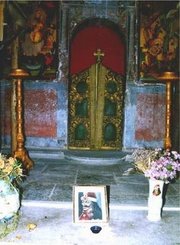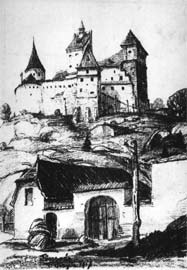What I remember most about my last visit at the Bran Castle is its being full with foreign tourists, most of them American. They come here with Bram Stockers stories in mind, hoping to see the castle of the dark prince draining people of blood to prolong his own despicable existence. They get to Romania, go to Bran, near Brasov, and reach a museum-castle actually showing the lifestyle and tastes of the Romanian Royal family. The Dark Ages are long gone from this castle and the only Dracula reminders are outside, where outdoor salespersons offer Dracula cups, paintings and other such souvenirs.
 Besides being placed in Transylvania by Stocker, are there any reasons for calling Bran Dracula’s Castle? Well, Vlad did enter Transylvania through here with his army, as the castle history states. I also remember some stories of him being a prisoner at the castle for a while. While searching for an invented ghost, those coming here miss out on the real story. A cruel prince o the Dark Ages, so cruel that no one dared to steal or kill in his country. Not out of an understanding of justice, but out of fear. We, new generations of his people, remember most of what was taught to us in school: he fought the Ottomans to keep them out of the country and of Europe and he impaled those he caught. No real mentioning of his excessive cruelty towards women and children and other such facts or myths. Here are some excerpts of the Romanian ruler’s life. More on the subject, in English, on Wikipedia. Vlad III the Impaler (Vlad Ţepeş : ['tsepeʃ] in common Romanian reference; also known as Vlad Dracula or Vlad Drăculea; November or December, 1431 – December 1476) was voivode (prince) of Wallachia, now part of Romania. His three reigns were in 1448, 1456 to 1462, and 1476. His Romanian surname Draculea (transliterated as Dracula in foreign languages of the historical documents where his name is mentioned) seems to come from his father's surname Dracul; the latter who was a member of the Order of the Dragon created by Emperor Sigismund of Hungary. Vlad's family had two factions, the Drăculeşti and the Dăneşti, sections always having a feeling of rivalry. His post-m ortem moniker of Ţepeş (Impaler) originated in his preferred method for executing his opponents, impalement. In Turkish, he was known as Kazıklı Bey (Impaler Prince). ortem moniker of Ţepeş (Impaler) originated in his preferred method for executing his opponents, impalement. In Turkish, he was known as Kazıklı Bey (Impaler Prince). There are several variants of Vlad III the Impaler's death. Some sources say he was killed in battle against the Turks near Bucharest in December of 1476. Others say he was assassinated by disloyal Wallachian boyars just as he was about to sweep the Turks from the field or during a hunt. Still other reports claim that Vlad, at the moment of victory, was accidentally struck down by one of his own men. Vlad's body was decapitated by the Turks and his head was sent to Istanbul and preserved in honey, where the sultan had it displayed on a stake as proof that Kazıklı Bey was dead. He was reportedly buried at a monastery located near Bucharest, yet the exact place of his burial remains unknown, as excavations at Snagov monastery, usually mentioned as his final resting place, have found no human remains. Photo originally uploaded on Wikipedia.
Vlad III Ţepeş is best known for his exceeding cruelty. Impalement was Ţepeş's preferred method of torture and execution. His method of torture - a horse attached to each of the victim's legs as a sharpened stake was gradually forced into the body. The end of the stake was usually oiled, and care was taken that the stake not be too sharp; else the victim might die too rapidly from shock. Normally the stake was inserted into the body through the anus and was often forced through the body until it emerged from the mouth. However, there were many instances where victims were impaled through other bodily orifices or through the abdomen or chest. Infants were sometimes impaled on the stake forced through their mother's chests. The records indicate that victims were sometimes impaled so that they hung upside down on the stake. of the stake was usually oiled, and care was taken that the stake not be too sharp; else the victim might die too rapidly from shock. Normally the stake was inserted into the body through the anus and was often forced through the body until it emerged from the mouth. However, there were many instances where victims were impaled through other bodily orifices or through the abdomen or chest. Infants were sometimes impaled on the stake forced through their mother's chests. The records indicate that victims were sometimes impaled so that they hung upside down on the stake. Impalement was Vlad the Impaler's favourite but by no means his only method of torture. The list of tortures employed by the prince is extensive: nails in heads, cutting off of limbs, blinding, strangulation, burning, cutting off of noses and ears, mutilation of sexual organs (especially in the case of women), scalping, skinning, exposure to the elements or to animals, and boiling alive. No one was immune to Vlad the Impaler's attentions. His victims included women and children, peasants and great lords, ambassadors from foreign powers and merchants. However, the vast majority of his European victims came from the merchants and boyars of Transylvania and his own country, Wallachia. Vlad Ţepeş committed even more impalements and other tortures against invading forces, namely Ottomans. It was once reported that an invading Ottoman army turned back in fright when it encountered thousands of rotting corpses impaled on the banks of the Danube. In Romania he is still considered by some to be a "savior" to the people of his country. He is also considered one of the greatest leaders and defenders of Romania and was voted one of "100 Greatest Romanians" in the Mari Români television series aired in 2006. The Bran Castle was built for two reasons: protection against the expansion of the Ottoman Empire, and its strategic position: being places on the main access road from Wallachia to Transylvania. Therefore the Hungarian king Ludovic I de Anjou agreed to have the fortress built in November 19, 1377. In 1382 the construction had already been completed. At the beginning of the XVthe century, the castle is given to the Wallachian ruler Mircea cel Batran. On this occasion, the custom placed here was moved to Brasov. In 1426, the castle is returned to Transylvanian rulers who were to nominate the person administrating the fortress.  At the beginning of the year 1459 Vlad the Impaler’s army will pass through Bran to further attach Brasov. After these events and further Ottoman attacks, the fortress will remain under Brasov ruling. Later on, as the fortress could no longer be a reliable defense, the border wi ll be moved and Bran will loose its important role in 1836. In 1920, the castle was given as a givt to the Romanian Royal family, who will own it for 27 years. In the next 10 years, many architectural changes have been made to the castle, trying to transform it into a modern summer residence. ll be moved and Bran will loose its important role in 1836. In 1920, the castle was given as a givt to the Romanian Royal family, who will own it for 27 years. In the next 10 years, many architectural changes have been made to the castle, trying to transform it into a modern summer residence. The Royal family brought electricity in the region, building a supplying factory in the castle area. Three phones were also brought here and an elevator was taking the castle’s inhabitants from one floor to another. Bran, along with the Balcic palace, was Queen Maria’s favorite residence.
Queen Maria has also turned the castle in a party place, many royal feasts being organized here. The queen left the castle to Princess Ileana after her death. The princess will then helped the castle develop in the 9 years she owned it.
Photo uploaded on the official museum site.
More historical details are also available on the museum’s official site. Cross posted at Light Within.
Tags: Toursim, Travel, Travel Destinations, Romania, Bran Castle, Vlad Tepes, Vlad the Impaler, Romanian History
|





He deserves to be called Dracula so as every empire did the same at that time, so he was one of the many origins that inspired authors to spin the Dracula myth?, this excess of violence against humanity, I think tales of vampires & Dracula back father than the Victorian era too. It absorbed its characters from every culture, no?
forms of torture, spread during these days in many places when the predominant power was only for the empire.
And the Thirst for blood was normal, for example in places like England or France the Guillotine was considered to be a show attended by all citizens!